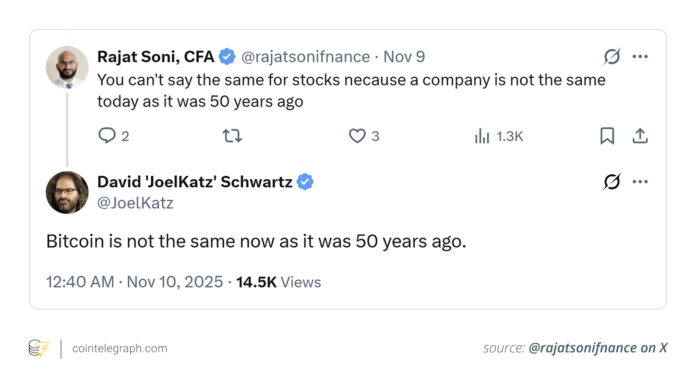Understanding Bitcoin’s Evolution: Separating Fact from Fiction
The recent statement by Ripple Chief Technology Officer David Schwartz that “Bitcoin today is not the same as it was 50 years ago” may have been made in jest, given that Bitcoin was only introduced in 2009. However, this comment highlights a crucial aspect of how people perceive Bitcoin’s development and the distinction between its core and edge innovations.
At the heart of Bitcoin’s evolution are two different speeds of change: the slow, consensus-driven modifications at its base layer and the rapid experimentation at its edges. Important upgrades, such as Taproot, undergo extensive testing through careful soft forks before implementation. In contrast, rapid changes like flash payments and ordinals occur without altering the core rules of Bitcoin, which is why headlines often move faster than the Layer 1 (L1) developments.
Schwartz’s joke came in the context of a thread where he argued that “1 BTC = 1 BTC” and that volatility exists in fiat terms, not in Bitcoin’s own unit of account. This perspective often fuels absolutist views about whether Bitcoin will change at all. It’s worth noting that XRP critic Rajat Soni, a CFA charterholder and a Bitcoin-focused financial commentator active on X, has also weighed in on these discussions.
The Temporal Confusion in Crypto Development
The joke reveals a mismatch in how people think about time in the context of cryptocurrency development. While headlines may suggest that Bitcoin is changing overnight, its foundational components have been built over decades, incorporating public key cryptography (Diffie-Hellman, 1976), Merkle Trees (1979), proof-of-work predecessors like Hashcash (1997 and 2002), and digital cash sketches like Wei Dai’s B-Money (1998).
Bitcoin’s design in 2008 combined these decades of cryptographic work into a single operating system. Once a protocol with real value reaches scale, the pace of change slows down significantly due to rising coordination costs, a phenomenon referred to as “log ossification.” This slow pace can give the impression that nothing is changing, but that is not the case. The Lindy Effect, which suggests that the longer a non-perishable technology has survived, the longer it is likely to survive, provides a useful framework for understanding this dynamic.
Changes at the Core of Bitcoin
At the basic level, Bitcoin is changing, but these changes are slow and only occur with broad approval. Most upgrades are soft forks that tighten the rules enforced by nodes, creating a coordination risk between different software versions. To mitigate this risk, the community has refined activation methods such as BIP-9 and BIP-8 version bits over the years.
A notable example of this process is Taproot, which was proposed years before its activation in November 2021. Taproot added Schnorr signatures and a new output type that improves efficiency and privacy without violating existing rules. The journey from idea to activation required extensive review and a period of signaling by miners before the rules came into effect.
Current debates, such as the re-activation of “OP_CAT” or the introduction of “OP_CTV” (BIP-119), follow a similar pattern, with proposals for incremental programmability subject to public research, risk analysis, and social review before activation can be considered. This process is as much about coordination between maintainers, validators, miners, and users as it is about code.
Rapid Changes at the Edges
The pace of change accelerates as you move away from Bitcoin’s base layer. Payment channels, like those in the Lightning Network, move transactions off-chain, routing them over a mesh and only touching Layer 1 as a backstop. This is why the Lightning Network iterates much faster than consensus changes, with core mechanisms like hashed timelock contracts and newer approaches such as Point Timelock Contracts (PTLCs) enabling value transfer between intermediaries without trust.
Ordinal numbers and inscriptions demonstrate the same fast-edge dynamics from a different angle, with new behaviors emerging through the use of existing rules. Casey Rodarmor’s plan to number satoshis and link them to data via Taproot-era scripts creates collectibles without changing the Bitcoin consensus, illustrating how the base protocol can remain unchanged while new markets and features emerge.
The Deeper Lesson
Schwartz’s “50 years of Bitcoin” quote encapsulates the real evolution of cryptocurrencies: a slow, conservative core that rarely changes and a fast, inventive edge that innovates rapidly. The slow core is intentional, with upgrades only coming after lengthy review and broad social consensus due to the high stakes involved.
However, this slowness does not mean stagnation. There are concrete avenues for change, such as the soft fork track for new opcodes, which could expand the programmability of Bitcoin transactions. These changes follow timelines that span multiple quarters or years, rather than news cycles. Meanwhile, new behaviors can emerge at the edges without affecting consensus, as seen with ordinal numbers and inscriptions.
In conclusion, when evaluating claims about Bitcoin’s “change,” it’s essential to specify where (base layer or edge) and how (consensus upgrade or emerging usage) these changes are occurring. This nuanced understanding helps to decode the evolution of Bitcoin and other cryptocurrencies, separating fact from fiction. For more insights into the dynamic world of cryptocurrency development, visit the original article.

